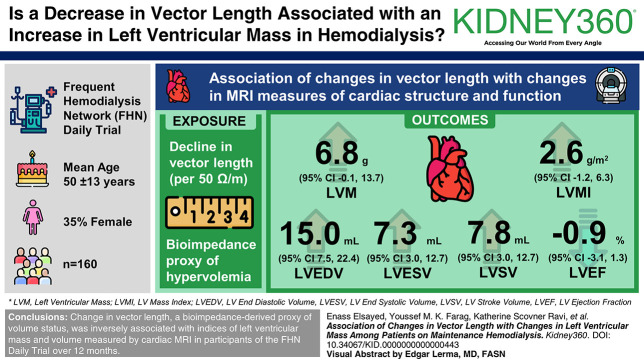- Record: found
- Abstract: found
- Article: found
Association of Changes in Vector Length with Changes in Left Ventricular Mass among Patients on Maintenance Hemodialysis : A Secondary Analysis of the Frequent Hemodialysis Network Daily Trial

Read this article at
Visual Abstract
Abstract
Key Points
-
Bioimpedance has been proposed as an objective method to assess volume status among patients receiving maintenance hemodialysis.
-
The Frequent Hemodialysis Network Daily Trial measured bioimpedance parameters of volume status (vector length) and cardiac magnetic resonance imaging at baseline and 12 months.
-
We observed that changes in vector length were inversely associated with changes in left ventricular mass and volume over a 12-month period.
Background
Hypervolemia is thought to be a major contributor to higher left ventricular mass (LVM), a potent predictor for cardiovascular mortality among patients on maintenance hemodialysis. We hypothesized that a decrease in vector length (a bioimpedance proxy of hypervolemia) would be associated with an increase in LVM.
Methods
Using data from the Frequent Hemodialysis Network Daily Trial ( n=160), we used linear regression to assess the association of changes in vector length from baseline to month 12 with changes in magnetic resonance imaging measures of LVM and other cardiac parameters. We adjusted models for the randomized group, baseline vector length, age, sex, race, body mass index, vascular access, dialysis vintage, history of hypertension, heart failure, and diabetes, residual kidney function, predialysis systolic BP, ultrafiltration rate, serum-dialysate sodium gradient, hemoglobin, phosphate, angiotensin-converting enzyme inhibitor or angiotensin receptor blocker use, erythropoietin dose, and equilibrated Kt/V.
Results
The mean age of the patients was 50±13 years; 35% were female. In the fully adjusted models, a decline in vector length (per 50 Ω/m; i.e., increase in volume) was associated with a 6.8 g (95% confidence interval [CI], −0.1 to 13.7) and 2.6 g/m 2 (95% CI, −1.2 to 6.3) increase in LVM and LVM index, respectively, and an increase of 15.0 ml (95% CI, 7.5 to 22.4), 7.3 ml (95% CI, 3.0 to 12.7), 7.8 ml (95% CI, 3.0 to 12.7), and −0.9% (95% CI, −3.1 to 1.3) in left ventricular end-diastolic volume, left ventricular end-systolic volume, left ventricular stroke volume, and left ventricular ejection fraction, respectively. The lowest tertile of change in vector length ( i.e., greater increase in volume) was associated with greater increases in left ventricular end-diastolic volume and left ventricular stroke volume, versus the highest tertile. There was no evidence of heterogeneity by randomized group.
Related collections
Most cited references33
- Record: found
- Abstract: not found
- Article: not found
A formula to estimate the approximate surface area if height and weight be known. 1916.
- Record: found
- Abstract: not found
- Article: not found
US Renal Data System 2020 Annual Data Report: Epidemiology of Kidney Disease in the United States
- Record: found
- Abstract: not found
- Article: not found
